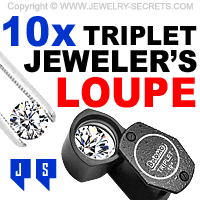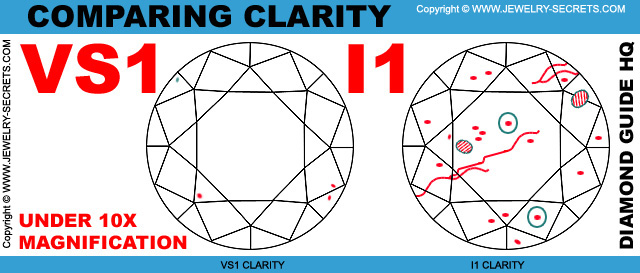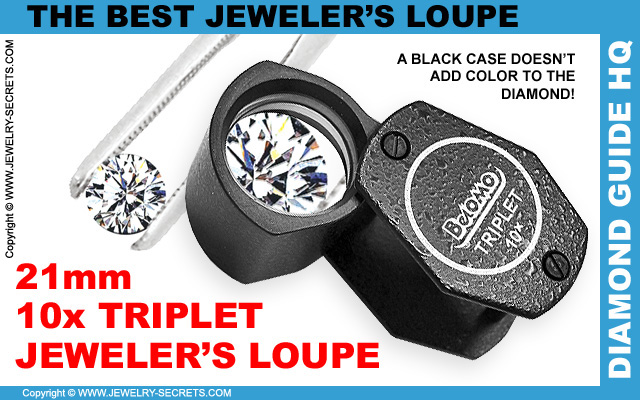10X TRIPLET JEWELER’S LOUPE
WHAT'S THE BEST JEWELER'S LOUPE ON THE MARKET?
This post contains affiliate links. If you use these links to buy something I may earn a commission. Thanks! As an Amazon Associate I also earn from qualifying purchases.

A jeweler’s loupe is a 10x magnification tool used by jeweler’s and customers to see inclusions, flaws, imperfections, blemishes, inscriptions in a diamond or gemstone.
A loupe allows you to instantly double check the clarity of a diamond. It helps you check for chips or nicks around the girdle. It lets you see the stone close up and quickly judge the make or grade of that particular diamond.
A loupe (pronounced loop) is a jeweler’s best friend.
What is a loupe?
A loupe is an optical viewer that has a series of specially curved lenses that allow you to magnify an object ten times it’s normal size (or whatever power you buy, 20x, 30x…). Ten power is what gems and diamonds are graded by.
Cheap jeweler’s loupes only have 2 lenses and can distort around the edges of the viewer. This can make your diamonds look blurry and even give you headaches or migraines because of the distortion.
The best loupe to buy:
A triplet jeweler’s loupe is the best jeweler’s loupe to buy. It’s a high quality, triple lens loupe that reduces distortion around the outside of the lens and fixes other abnormalities. Color correction is also a big fix. Without color correction a diamond can appear different hues or shades (a black case works the best as it doesn’t add any color into the diamond). This third lens really does make all the difference in the world.
No matter what, a jeweler’s loupe is still not the easiest tool to use. You have to train your eyes to get used to viewing objects magnified ten times. You have to get used to focusing and holding the stone at just the right angle and right distance to observe the microscopic flaws inside.
It’s not easy.
Most customers have an awkward time holding a loupe. They see jeweler’s holding one, but when they try to mimic us, they are all over the place with it.
Some unexperienced people hold the loupe out at arms length and try to see the diamond 2 feet away… This never works! Others hold it a foot from their eye and close the other eye. Some just peer through the loupe quickly and nod like they see what you’re talking about.
Customers soon realize one thing: using a jeweler’s loupe takes practice.
So how do you use a loupe?
Using a loupe takes practice and patience. So first things first, get a loupe and open it up. A hand-held loupe hinges open and you can often stick your index finger through this open case lid which steadies the loupe and makes viewing easier (you should be able to do this with no problem on 21mm cases, depending on the size of your fingers). If you can’t stick your finger through the case lid, just grasp the open loupe and bring it up to your good eye about an inch away.
One huge thing to learn here is this: don’t lean forward over the loupe. Your shadow will fall over the diamond you’re viewing and darken it making inclusions harder to see. So tilt your head back slightly to allow light to enter the stone and make the flaws stand out.
Hold the loupe up with one hand about an inch away from your eye. With your other hand, bring the diamond up to the Loupe so you can observe it (clean the diamond first to remove any dirt, dust, fingerprints or oils from the surface of the stone). It works better if the diamond is held in a pair of locking diamond tweezers. This allows you to see into the diamond easily without getting your bulky fingers in the way. Just make sure the diamond is clamped properly. That’s why I like locking tweezers, you do have to be careful though so you don’t chip the edges of the diamond when clamping it (the girdle is the weakest part of a diamond).
Bring the diamond up in front of the loupe about an inch away. You should now be able to see inside the diamond from this distance. Tilt it up to let more light in if you have to and play around with the viewing distance by moving the diamond in and out until the stone comes into focus.
You should be able to view the stone from all angles doing this. Peer into the stone, rotate the stone, tilt the stone in the light, rock it back and forth in order to see under the facets, view the girdle, pavilion, and culet.
Everything that you can see with a microscope you’ll be able to see with a professional jeweler’s loupe. But even for an expert, it still takes training and practice.
Seeing tiny pinpoints, hairline feathers and trigons can be tough because of a diamond’s size and sparkles, until you know this little secret…
The secret to holding a loupe
There really is a little secret that all jewelers use that helps them view diamonds easier.
What is this?
Leverage!
Leverage is the key to success.
Anytime you view an object this close up (like a macro lens on a camera), any little slight movement takes the item out of focus. Even your own breathing can keep your hands moving slight enough to keep the stone and inclusions hidden, blurry and out of sight. I find too much coffee even makes my hands shake slightly. Not cool.
Things like this can make it very difficult to use a loupe until you get the leverage.
Leverage is stabilizing your hands so they don’t move away from your eye. And there’s a simple way to do this…
Take your hand that’s holding the Loupe and rest your thumb up against your cheek bone. Then bring your other hand in (the hand holding the diamond) and lock your wrists together so you can pivot them like a hinge.
Locking your hands in this position keeps the diamond the same distance away from your eye whether you breath or not (sometimes I do hold my breath to steady my movements). Planting your thumb down will keep the diamond in focus and allow you to see all the microscopic details and make of the stone.
Leverage works wonders and it will work for you. Plus, it will make you feel more comfortable and confident holding and using a loupe.
No matter what, a loupe is still not the easiest thing to use for an untrained eye. This is why I usually recommend using a 10x microscope instead.
The microscope is easy.
A 10x powered microscope really is the best tool to view diamonds with for a couple of great reasons:
1) It let’s you use 2 eyes (binocular) to view the diamonds with. This makes it easier since people have a hard time viewing through only one eye into a magnifying glass.
2) It adds darkfield/brightfield back light into the diamond so you can see the inclusions and flaws much easier.
Microscopes are absolutely wonderful, but expensive, like these Amscope jeweler’s microscopes here.
Microscopes are the ideal tool to use for judging diamond clarity and diamond color, not to mention diamond cut, proportions and symmetry.
I use one everyday. :)
Sometimes customers are quite funny when it comes to microscopes. Many haven’t used one since the seventh grade, but once they start viewing diamonds, they are hooked.
I recommend viewing every diamond you purchase. Even if it’s certified and comes with a diamond report and plot… You must view the stone.
Make sure the clarity and inclusions match up and compare them with what the certification says. Diamonds are a magical and microscopic world. You have to see them close up to appreciate their true beauty.
Comparing a VS1 diamond to an I1 clarity diamond is breathtaking. See the image below…

These two diamond clarities are so strikingly different they will knock your socks off. It will open your eyes and lean you towards better quality diamonds, no doubt.
So whether you use a jewelers loupe or a jeweler’s microscope, make sure you take the time to check your diamonds out.
Look at the diamond from all angles and even upside down. View the girdle. View the inscription. Look for blemishes on the surface of the stone.
What else in life could you have such an opportunity to view that close up and scrutinize tiny characteristics that makes each and every diamond different? You’ll understand why some diamonds can look similar, but be thousands of dollars apart. It really is amazing.
When customers scope a diamond for the very first time, and when they compare low quality to high quality, they are blown away.
This is what quality and clarity is all about…
It makes it all click. This is why one diamond sparkles more than another. This is why people fall in love with diamonds and why diamonds are a symbol of strength, purity, luxury and love. Their beauty is breathtaking.
So grab a loupe and check out some diamonds today. You’ll never look at diamonds the same way again. I guarantee it. :)
What loupe do I recommend?
A 10x 21mm jeweler’s triplet loupe. The magnification is perfect. The distortion is gone. The viewer is large. And a black case adds no color to the diamond.
Look for the words “triplet 10x” to be right on the case to make sure you’re buying the correct magnification. You can buy hand-held Loupes in various mm sizes as well like, 18, 20, 21mm, but the smaller the mm, the smaller the lens is which makes it harder to see through. I always advise buying a bigger lens (21mm) so you can see more of the diamond at once. You won’t regret it.
My favorite Loupe is the BelOMO jeweler’s metal loupe which is a top of the line Loupe that I recommend for both amateurs and professionals. Plus you can also use this loupe for viewing other things like stamps, rocks, minerals, jewelry, coins… In fact, with a loupe like this, you’ll be viewing everything close up… Your fingernails, bugs, the prongs of your ring… :)
TECHNICAL DETAILS:
The black case BelOMO 10x21mm triplet jeweler’s folding loupe has an extremely high quality triplet Lens that provides a very sharp, bright, and undistorted viewing area as found in more expensive magnifiers.
Specifications:
10x magnification ratio (10 times)
Large 21mm achromatic color correction triplet Lens
Focal distance: 1.1 inch, 28mm – Linear field of view: 0.65 inch, (17mm)
Dimensions: 1.5 x 1.38 x 1.25 inches, Weight: 2.08 once
So head over to Amazon and pick up the best loupe money can buy.
Cheers! :)















Leave a comment